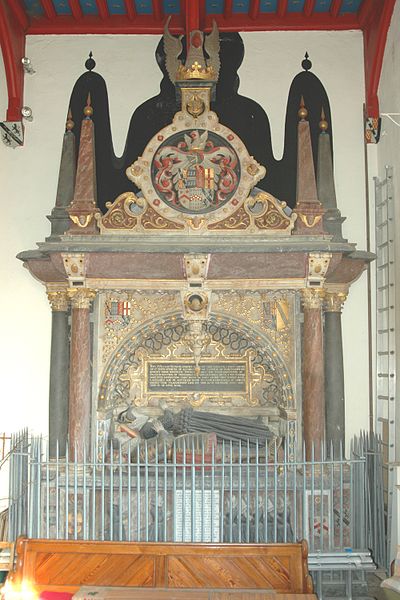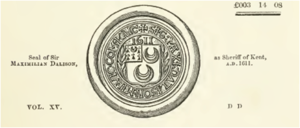MRP: Sir Maximilian Dallison
Sir Maximilian Dallison
b. 1577, d. 1631
THIS ENTRY REQUIRES EDITING
Contents
Family
Sir Maximilian Dallison was the only son of the lawyer William Dallison (?-1581) of Lincolnshire and Kent and of Silvester (1554-1587), daughter and heir of Robert Dene, gent., of Halling, Kent, and of Margaret Whyte. His father, William Dallison, died before his mother, who went on to marry the lawyer and writer, William Lambarde, by whom she had four further children. As a result Sir Maximilian had one full elder sister, named Silvester after her mother, and four half brothers and sisters. Sir Maximilian eventually inherited the Bishop's Place (or Palace) in Halling, which he passed subsequently to his own son, William, Elizabeth Dallison's husband. Sir Maximilian's father died considerably before his own majority, whereas Sir Maximilian died just shortly after his own son's majority. The absence of a paternal figure in his son's life as a young married man was probably not helpful.
A church brass survives in the parish church of Lower Halling, Kent, depicting Sir Maximilian's mother on her death bed, with her six children - Her eldest daughter Silvester and the future Sir Maximilian stand to her left, and to her right her four children by her second husband, with William and Margaret standing and with twins Gore and Fane in a cradle.
See - church brass of Sir Maximilian's mother
See - detail of church brass of Sir Maximilian's mother
Study, legal and commercial activities
Sir Maximilian studied at Gray's Inn, and inherited his father's legal books and chamber at Gray's Inn, which had been bequeathed in his minority to his father's brother. He was active in north Kent gentry and Rochester town circles, serving as bridge warden for the Rochester bridge, as a trustee of a local hospital, and as Sheriff of Kent. It is not clear what his activities were in London, or how he and his family split their time between the houses in St. John Street, Clerkenwell, and in Halling, Kent.
Marriage
He married twice. Firstly to Paulina Sondes, daughter of Sir Michael Sondes, who predeceased him and bore no children. Secondly he married Mary Spencer, daughter of Sir William Spencer of Yarnton, Oxfordshire in 1608. They had seven sons and three daughters, of whom five sons and two daughters were alive in 1630. Sir Maximilian died two weeks before the marriage of his eldest son to Elizabeth Oxenden, a match he had long favoured. Mary died just fifteen days after him, having lived to see her eldest son married to Elizabeth a day before her death. Extremely sick and shortly before her death she told Margaret Oxenden, Elizabeth's mother that "she hoped it would prove a happy marryage."
Sir Maximilian Dallison's relationship with the Sondes family was a commercial one as well as personal, with an indenture dated 20th March 1st year of James I between Sir Maximillian and Sir Michael Sondes of Throwley, Kent. The indenture included reference to the White Hart and to a substantial acreage of land in Halling, Snodland, Padlesworth, and Birling "all which were hereditaments of Silvestre, mother of the aforesaid Sir Max:n Dalyson, and daug. and heire of Rob:t Deane, late of Hallinge, gent, deceased."
Location
Sir Maximilian Dallison had both a house in St. John Street, Clerkenwell, in Middlesex, and in Halling, Kent. He and his family appear to have spent significant time in London and Middlesex. For example, London Revidium states that two of his daughters, Jane (January 12th 1611) and Elizabeth (May 9th 1614) and his second son Phillip (April 22nd 1613) were baptised at the parish church of St. Alban's, Wood Street in the ward of Cripplegate within. A history and topography of St. Mary, Islington states that his eldest daughter, Penelope, was baptised in Islington on May 9th 1611.
Sir Maximilian Dallison's will, 1630
Sir Maximillian Dallison's will is an interesting one. He refers to his two daughters Penelope and Theodora, together with his sons, William, Phillip, Arthur, John and Spencer. He chose to split guardianship responsibilities, entrusting Penelope and Theodora to his wife, and his younger sons to his executors. He was concerned about discipline and instructed that "in case any of my said younger sons shall prove refractory" and shall not accept the advice and governance of his executors then their legacies should be void. As executors he chose Sir Edward Hales and the lawyer Moulton Lambarde, his step-brother, son of the Chancery lawyer, his step-father William Lambarde. One of his three executors was Ralph Whitfield (Whitfeild) esq., who was also the first of nine witnesses to the will. Whitfield is probably the lawyer of that name who later became brother-in-law to Robert Raworth, Elizabeth Dalyson's friend and lawyer. He chose his kinsman Charles Dallison Esquire and Thomas Clottery of the Inner Temple, gent., as his remaining overseers. A separate part of his will deals with his disposition of real estate. In this part he refers to two sets of conveyances. Four conveyances dated May 2nd 1627 and four conveyances dated January 18th 1629/30.
A considerable portion of the part of the will dealing with real estate refers to his indenture of marriage dated July 23rd ?1609. In this indenture he committed to Sir William Spencer and to Thomas Spencer Esq, deceased, to conveying the real estate of Bishop's place and associated property to his heirs male of the body of his wife Mary (nee Spencer). The language seems to imply multiple males, rather than simple male primogeniture, but does not state how the estate should be divided. He itemises the estate as "the Bishop's place with all houses buildings, dovehouses, yards, orchards, gardens and out houses there unto belonginge". These contained by estimation "Thirty acres of fresh marshes, lying in severall peeces, and tenn acres of meadow lying in severall peeces, paying for the same the yearely cost of twenty five pounds of lawfull money of England."
Interestingly there were nine witnesses to the will, including the above mentioned Ralph Whitfield (Whitfeild) and Robert Raworth. Thus the connection of Robert Raworth with the Dallison family predates the marriage of Elizabeth Oxenden to Sir Maximilian's son William, which was in November 1631, one year after the will was made and shortly after Sir Maximilian's death. This is of some relevance given subsequent litigation in the 1640s and 1650s over the Bishop's place estate, since Robert Raworth is likely to have had at least some knowledge of Sir Maximilian's affairs and intent towards his estate.
In the absence of copies of the two sets of four indentures of May 1627 and January 1629/30 it is unclear what Sir Maximillian Dallison was intending to do with his real estate, other than giving his wife the option of residing in Halling or St. John's Street. In the later Stone v. Dallison suits, which last from 1640-42 till at least 1651 there was a fundamental dispute of fact and law as to whether Sir Maximillian gave his eldest son only an interest in life in the Bishop's place estate with remainders to the other male sons and heirs, or whether William, his eldest son, had an "absolute estate of inheritance in fee simple" (see C 3/429/50 (1640-42) and C 22/460/21 (1651))
Guardianship of Sir Maximilian's children in 1630s
The 'Dalison Documents', published in Archaeologia cantiana (1883), provide extracts from the accounts of Sir Maximilian Dallison's executors. These provide an insight into the life and education of the younger children, though not of William (b.1609, d.1642), the eldest son, who was just above the age of majority at the time of his father's death.
Arthur (b.1618, d.?), John (b.1620, d.?) and Spencer Dallison (b.1626, d.?) were tutored by Mr. Dukeson, a schoolmaster in Islington. Expenditure on servants to retrive Arthur from Lincolnshire was required after he ran away from school. Phillip (b.1613, d.?), the oldest of the younger brothers, was tutored close to London. The boys also had writing masters. The girls, Penelope (b. 1611, d.?) and Theodosia (b.1619, d.?), received private tutoring in the playing of the virginal, voice, and in the French language. The younger children occasionally visited East Greenwich, where their guardian had his seat.
Sir Maximilian's seal, 1611
Sources
Primary
PROB 11/115 Wingfield 1 - 56 - Will of Sir William Spencer of Yarnton, Oxfordshire, proved 03 February 1610
PROB 11/63 Darcy - Will of William Dallison, proved November 14th 1584
PROB 11/160 St. John 69 - 138 - Will of Sir Maximilian Dallison, proved November 18th 1631
PR
SP16/266/80
- Robertson, Scott, ‘Dalison documents’, Canon Scott Robertson in Archaeologia cantiana, vol. 15 (London, 1883), pp. 386-401
- Inventory of William Dallison, 1584, in William Archibald Scott, Dalison Documents. From the Muniment Chests at Hamptons, near Tunbridge. And a Pedigree in Archaeologica Cantiana, vol. 15 (London, 1883), pp. 391-393
- The Lambarde Diary, copied from from the original M.S. in the possession of Multon Lambarde, Esq., Beechmont’, in J.J.Howard (ed.), Miscellanea Genealogica et Heraldica (London, 1876), p. 103)
Secondary
- Aveling, S.T., ‘Rochester Inns’, in Archaeologica Cantiana, vol. 21 (London, 1858), pp. 322-323)
Malcolm, James P., Londinium redivivum; or An antient history and modern description of London (London, 1803),p. 510
Nelson, John, The history, topography, and antiquities of the Parish of St. Mary Islington, in the County of Middlesex (London, 1811), p. 359
- Robertson, Scott, ‘Dalison pedigree’, in Archaeologia cantiana, vol. 15 (London, 1883), pp. 402-404
Image credits
Photograph of signature of (Sir) Maximilian Dalyson, ca. 22nd January 1630/31, C22/598/30, taken from marginal notes with signature on p. 1 of two page letter written in London by Sir Maximilian Dalyson and sent to his "country servant", Owen Claxton. The letter was used as the basis for Claxton's deposition on 31st March 1631 in Rochester. Photograph taken for personal study by Colin Greenstreet
Engraving of Silvester Dene on her deathbed, taken from church brass of the same event in Halling parish church, Anonymous, Profile of Lambarde family in Visitation of the county of Kent, in Archaeologica cantiania, vol. 5 (London, 1863), p. 250. Image is out of copyright
Photograph of the funeral monument of Sir William Spencer of Yarnton, Oxfordshire, and his wife
Seal of Sir Maximilian Dalyson. Reproduced in XXXXX. Image is out of copyright


